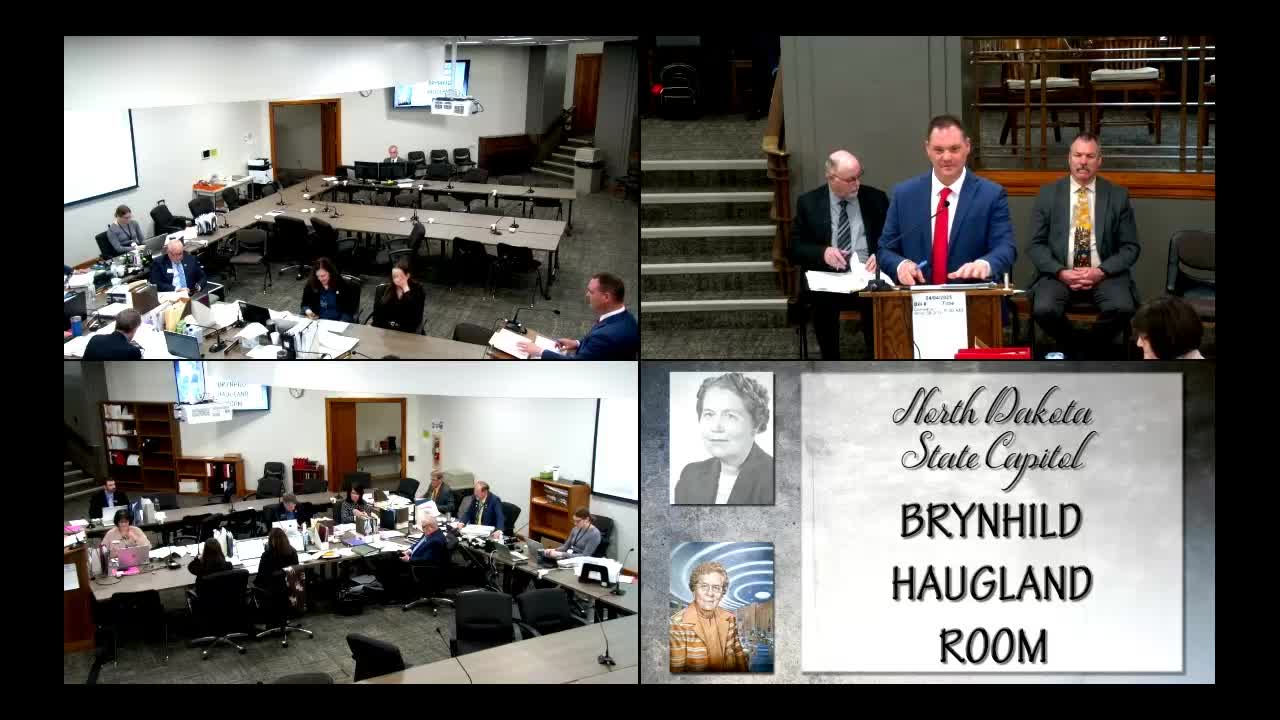Panel weighs Mineral Resources staffing, considers using abandoned‑well fund for reclamation technicians
April 04, 2025 | Appropriations - Government Operations Division, House of Representatives, Legislative, North Dakota
This article was created by AI summarizing key points discussed. AI makes mistakes, so for full details and context, please refer to the video of the full meeting. Please report any errors so we can fix them. Report an error »

The House Appropriations Government Operations division discussed budget 474 for the Department of Mineral Resources (DMR), including a request for additional FTEs and a plan to place reclamation specialists in field offices.
DMR Director Nathan Anderson told the committee the agency’s workload is growing — producing wells and regulated pipeline miles have increased — while some staff positions remain unfilled. Anderson and staff presented a priority list that included an executive/deputy director, a land-and-legal specialist (a re-purposed CCUS position), and reclamation technicians for field offices in Williston and Dickinson.
Committee members scrutinized how to fund additional reclamation staff. Representative Kempnick proposed using the Abandoned Oil and Gas Well Reclamation Fund to pay some or all of the field reclamation positions; staff noted the fund held roughly $38 million as of March 1 and has a statutory cap of $75 million. Adam (committee staff) said the fund receives operator fees and up to $7.5 million per year from oil and gas tax collections, and recently has grown due to federal grants for plugging and reclamation.
Key points of discussion: Committee members wanted the DMR to prioritize positions and clarified which positions were conversions of existing appropriations versus entirely new FTEs. Anderson explained one position previously authorized for CCUS had been repurposed as a land-and-legal specialist and therefore did not necessarily require new funding. The committee and staff discussed adding a deputy director position (new) and reassigning or removing a permitting technician to accommodate priorities.
Reclamation work and funding options: DMR staff described recent and ongoing reclamation work, including a request to help process bond releases and close out hundreds of reclaimed sites. Members asked whether reclamation specialists could be funded from the Abandoned Oil and Gas Well Reclamation Fund; staff said that is legally possible but would require statutory changes or explicit appropriation language. Representative Kempnick proposed drafting trigger language so additional reclamation technicians would be funded when certain workload thresholds are reached; members asked staff to draft options for statutory language.
Numbers and timing: Anderson presented workload graphs showing FTE levels (about 108 in 2024), pipeline miles and well counts trending upward, and a history of unfilled positions. Committee members noted the department had received some FTEs in prior transfers (two from Bank of North Dakota servicing) and had absorbed the HOME program and other work from Commerce without commensurate staffing in all cases. Staff said DMR would supply a revised worksheet showing how many dollars of salaries and operating costs could be reallocated to match the committee’s chosen priorities.
Ending: The committee agreed to leave the matter open for staff to prepare statutory language and worksheet adjustments that would permit funding one or more reclamation technicians from the Abandoned Oil and Gas Well Reclamation Fund and to clarify which positions were conversions versus new appropriations.
DMR Director Nathan Anderson told the committee the agency’s workload is growing — producing wells and regulated pipeline miles have increased — while some staff positions remain unfilled. Anderson and staff presented a priority list that included an executive/deputy director, a land-and-legal specialist (a re-purposed CCUS position), and reclamation technicians for field offices in Williston and Dickinson.
Committee members scrutinized how to fund additional reclamation staff. Representative Kempnick proposed using the Abandoned Oil and Gas Well Reclamation Fund to pay some or all of the field reclamation positions; staff noted the fund held roughly $38 million as of March 1 and has a statutory cap of $75 million. Adam (committee staff) said the fund receives operator fees and up to $7.5 million per year from oil and gas tax collections, and recently has grown due to federal grants for plugging and reclamation.
Key points of discussion: Committee members wanted the DMR to prioritize positions and clarified which positions were conversions of existing appropriations versus entirely new FTEs. Anderson explained one position previously authorized for CCUS had been repurposed as a land-and-legal specialist and therefore did not necessarily require new funding. The committee and staff discussed adding a deputy director position (new) and reassigning or removing a permitting technician to accommodate priorities.
Reclamation work and funding options: DMR staff described recent and ongoing reclamation work, including a request to help process bond releases and close out hundreds of reclaimed sites. Members asked whether reclamation specialists could be funded from the Abandoned Oil and Gas Well Reclamation Fund; staff said that is legally possible but would require statutory changes or explicit appropriation language. Representative Kempnick proposed drafting trigger language so additional reclamation technicians would be funded when certain workload thresholds are reached; members asked staff to draft options for statutory language.
Numbers and timing: Anderson presented workload graphs showing FTE levels (about 108 in 2024), pipeline miles and well counts trending upward, and a history of unfilled positions. Committee members noted the department had received some FTEs in prior transfers (two from Bank of North Dakota servicing) and had absorbed the HOME program and other work from Commerce without commensurate staffing in all cases. Staff said DMR would supply a revised worksheet showing how many dollars of salaries and operating costs could be reallocated to match the committee’s chosen priorities.
Ending: The committee agreed to leave the matter open for staff to prepare statutory language and worksheet adjustments that would permit funding one or more reclamation technicians from the Abandoned Oil and Gas Well Reclamation Fund and to clarify which positions were conversions versus new appropriations.
View full meeting
This article is based on a recent meeting—watch the full video and explore the complete transcript for deeper insights into the discussion.
View full meeting
